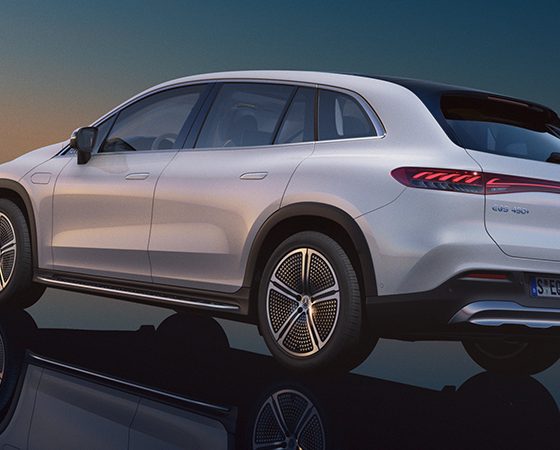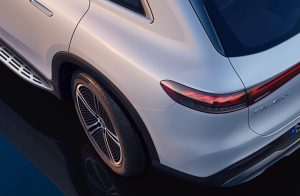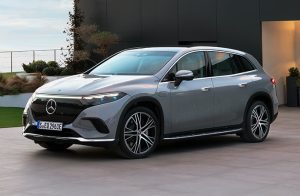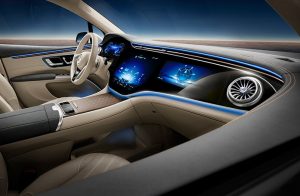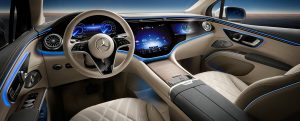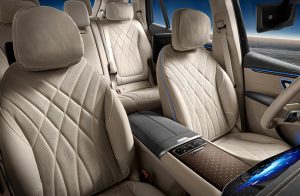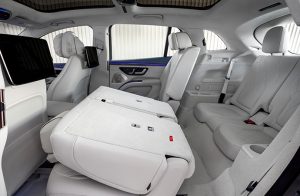Mercedes-Benz has unveiled its new EQS SUV variant that will go on sale later this year.
Mercedes has expanded their EQ line of electric vehicles with the new EQS SUV. The 7-seater luxury SUV starts at $130,000, features an optional all-wheel-drive system capable of 536 horsepower, has an estimated range of up to 410 miles, and can charge at a rate of 200kW via fast charger (10%-80% in 30min).
Mercedes were looking to take the fight of the luxury sedan to the likes of Tesla and Lucid with their EQS sedan, but now they hope to challenge the likes of the Tesla Model X with their EQS SUV. The relatively sparse 7-seater EV market makes the Mercedes an early contender, but they are bringing a great option to the table.
- Credit: Mercedes
- Credit: Mercedes
- Credit: Mercedes
Much like the EQS sedan the SUV is based on, the vehicle is capable of incredible range, 410 miles, when equipped with the single motor rear-wheel drive option. The SUV also offers similar luxury features. An optional cross-dash display system with three screens; driver, center console, and passenger. Optional rear-wheel steering and all-wheel drive system boosts horsepower to 536, up from 355 in the single motor. And a 200kW capable charging system means that Mercedes can charge the EQS SUV’s enormous 107.8kWh battery in just 30min to 80%.
In a similar trend to other legacy car makers like Cadillac, Mercedes has made the new EQS SUV enormous. The vast SUV stretches over 16.5 feet long and weighs an earth-shattering 7716 pounds. But with that size comes all of the luxury interior features you can expect from a vehicle with a starting price over $100,000. Massaging and heated seats for all passengers, displays available for every Gen Z-er being taken to soccer practice, and Mercedes’ iconic interior lighting system draping over the interior.
- Credit: Mercedes
- Credit: Mercedes
- Credit: Mercedes
- Credit: Mercedes
- Credit: Mercedes
It is clear the target of the Mercedes EQS SUV, the Tesla Model X, and the vehicle certainly does its best to outshine its American counterpart. The EQS SUV has more range, more passenger space (especially in the third row), and more comfort amenities for passengers. However, it is substantially less powerful than the comparably priced Tesla Model X Plaid. At the same time, Mercedes is undoubtedly working on an AMG variant that will go toe-to-toe with Tesla’s monster.
However, they will not be the only manufacturer looking to enter the 7-seater market. Tesla is likely looking to update their long-in-the-tooth vehicle lineup, Hyundai/Kia are both looking to bring a large 7-seater option to market, BMW is likely working on an iX7 to compliment its current 5-seater option, and Lucid’s Project Gravity is in the works as well. Not to forget Ford and GM, who have long dominated the gargantuan SUV market with the likes of the Ford Expedition, Lincoln Navigator, Chevy Suburban, and Cadillac Escalade. This will be an exciting market to watch in the coming years.
What do you think of the article? Do you have any comments, questions, or concerns? Shoot me an email at william@teslarati.com. You can also reach me on Twitter @WilliamWritin. If you have news tips, email us at tips@teslarati.com!

Elon Musk
Tesla’s Elon Musk: 10 billion miles needed for safe Unsupervised FSD
As per the CEO, roughly 10 billion miles of training data are required due to reality’s “super long tail of complexity.”

Tesla CEO Elon Musk has provided an updated estimate for the training data needed to achieve truly safe unsupervised Full Self-Driving (FSD).
As per the CEO, roughly 10 billion miles of training data are required due to reality’s “super long tail of complexity.”
10 billion miles of training data
Musk comment came as a reply to Apple and Rivian alum Paul Beisel, who posted an analysis on X about the gap between tech demonstrations and real-world products. In his post, Beisel highlighted Tesla’s data-driven lead in autonomy, and he also argued that it would not be easy for rivals to become a legitimate competitor to FSD quickly.
“The notion that someone can ‘catch up’ to this problem primarily through simulation and limited on-road exposure strikes me as deeply naive. This is not a demo problem. It is a scale, data, and iteration problem— and Tesla is already far, far down that road while others are just getting started,” Beisel wrote.
Musk responded to Beisel’s post, stating that “Roughly 10 billion miles of training data is needed to achieve safe unsupervised self-driving. Reality has a super long tail of complexity.” This is quite interesting considering that in his Master Plan Part Deux, Elon Musk estimated that worldwide regulatory approval for autonomous driving would require around 6 billion miles.
FSD’s total training miles
As 2025 came to a close, Tesla community members observed that FSD was already nearing 7 billion miles driven, with over 2.5 billion miles being from inner city roads. The 7-billion-mile mark was passed just a few days later. This suggests that Tesla is likely the company today with the most training data for its autonomous driving program.
The difficulties of achieving autonomy were referenced by Elon Musk recently, when he commented on Nvidia’s Alpamayo program. As per Musk, “they will find that it’s easy to get to 99% and then super hard to solve the long tail of the distribution.” These sentiments were echoed by Tesla VP for AI software Ashok Elluswamy, who also noted on X that “the long tail is sooo long, that most people can’t grasp it.”
News
Tesla earns top honors at MotorTrend’s SDV Innovator Awards
MotorTrend’s SDV Awards were presented during CES 2026 in Las Vegas.

Tesla emerged as one of the most recognized automakers at MotorTrend’s 2026 Software-Defined Vehicle (SDV) Innovator Awards.
As could be seen in a press release from the publication, two key Tesla employees were honored for their work on AI, autonomy, and vehicle software. MotorTrend’s SDV Awards were presented during CES 2026 in Las Vegas.
Tesla leaders and engineers recognized
The fourth annual SDV Innovator Awards celebrate pioneers and experts who are pushing the automotive industry deeper into software-driven development. Among the most notable honorees for this year was Ashok Elluswamy, Tesla’s Vice President of AI Software, who received a Pioneer Award for his role in advancing artificial intelligence and autonomy across the company’s vehicle lineup.
Tesla also secured recognition in the Expert category, with Lawson Fulton, a staff Autopilot machine learning engineer, honored for his contributions to Tesla’s driver-assistance and autonomous systems.
Tesla’s software-first strategy
While automakers like General Motors, Ford, and Rivian also received recognition, Tesla’s multiple awards stood out given the company’s outsized role in popularizing software-defined vehicles over the past decade. From frequent OTA updates to its data-driven approach to autonomy, Tesla has consistently treated vehicles as evolving software platforms rather than static products.
This has made Tesla’s vehicles very unique in their respective sectors, as they are arguably the only cars that objectively get better over time. This is especially true for vehicles that are loaded with the company’s Full Self-Driving system, which are getting progressively more intelligent and autonomous over time. The majority of Tesla’s updates to its vehicles are free as well, which is very much appreciated by customers worldwide.
Elon Musk
Judge clears path for Elon Musk’s OpenAI lawsuit to go before a jury
The decision maintains Musk’s claims that OpenAI’s shift toward a for-profit structure violated early assurances made to him as a co-founder.

A U.S. judge has ruled that Elon Musk’s lawsuit accusing OpenAI of abandoning its founding nonprofit mission can proceed to a jury trial.
The decision maintains Musk’s claims that OpenAI’s shift toward a for-profit structure violated early assurances made to him as a co-founder. These claims are directly opposed by OpenAI.
Judge says disputed facts warrant a trial
At a hearing in Oakland, U.S. District Judge Yvonne Gonzalez Rogers stated that there was “plenty of evidence” suggesting that OpenAI leaders had promised that the organization’s original nonprofit structure would be maintained. She ruled that those disputed facts should be evaluated by a jury at a trial in March rather than decided by the court at this stage, as noted in a Reuters report.
Musk helped co-found OpenAI in 2015 but left the organization in 2018. In his lawsuit, he argued that he contributed roughly $38 million, or about 60% of OpenAI’s early funding, based on assurances that the company would remain a nonprofit dedicated to the public benefit. He is seeking unspecified monetary damages tied to what he describes as “ill-gotten gains.”
OpenAI, however, has repeatedly rejected Musk’s allegations. The company has stated that Musk’s claims were baseless and part of a pattern of harassment.
Rivalries and Microsoft ties
The case unfolds against the backdrop of intensifying competition in generative artificial intelligence. Musk now runs xAI, whose Grok chatbot competes directly with OpenAI’s flagship ChatGPT. OpenAI has argued that Musk is a frustrated commercial rival who is simply attempting to slow down a market leader.
The lawsuit also names Microsoft as a defendant, citing its multibillion-dollar partnerships with OpenAI. Microsoft has urged the court to dismiss the claims against it, arguing there is no evidence it aided or abetted any alleged misconduct. Lawyers for OpenAI have also pushed for the case to be thrown out, claiming that Musk failed to show sufficient factual basis for claims such as fraud and breach of contract.
Judge Gonzalez Rogers, however, declined to end the case at this stage, noting that a jury would also need to consider whether Musk filed the lawsuit within the applicable statute of limitations. Still, the dispute between Elon Musk and OpenAI is now headed for a high-profile jury trial in the coming months.

